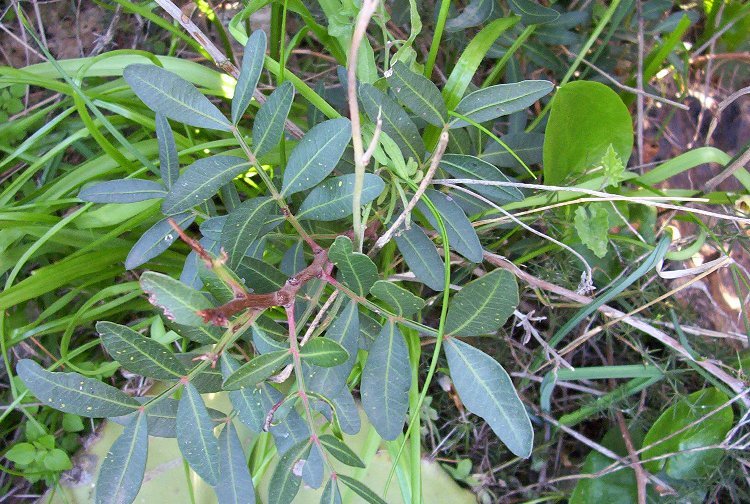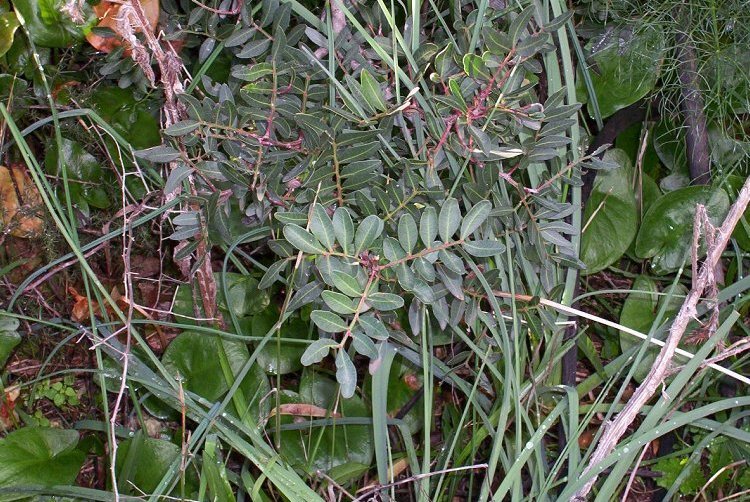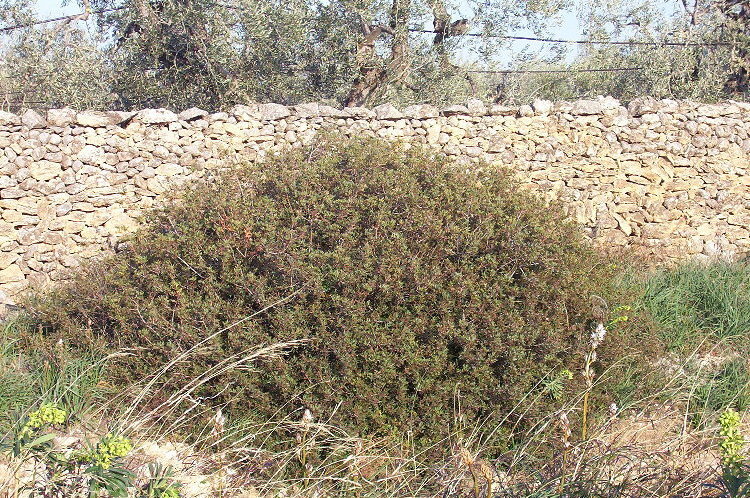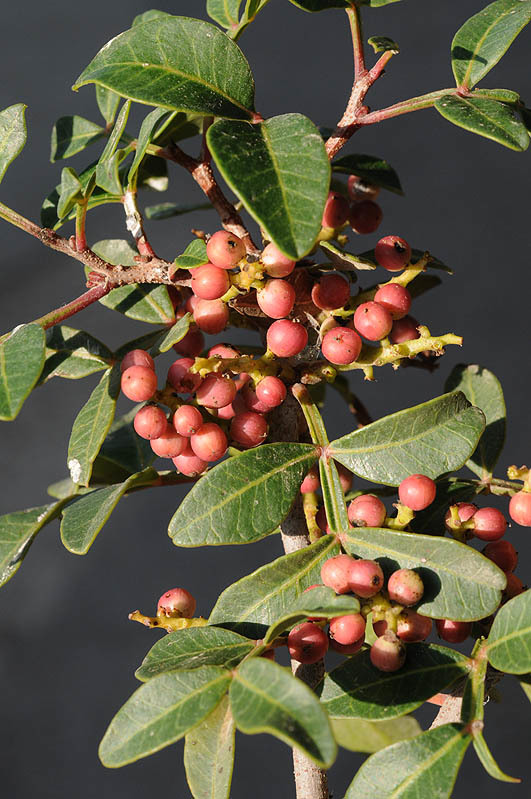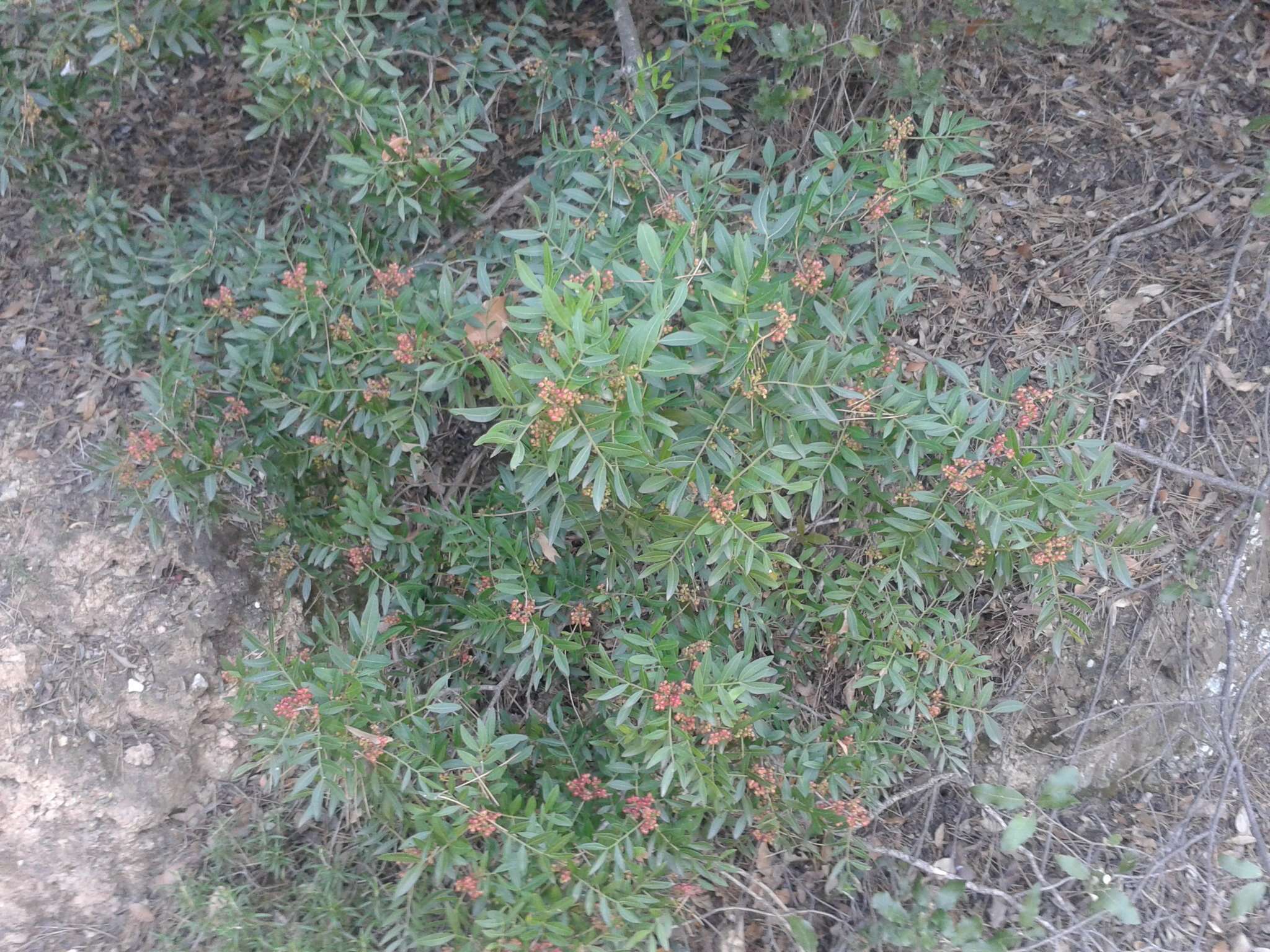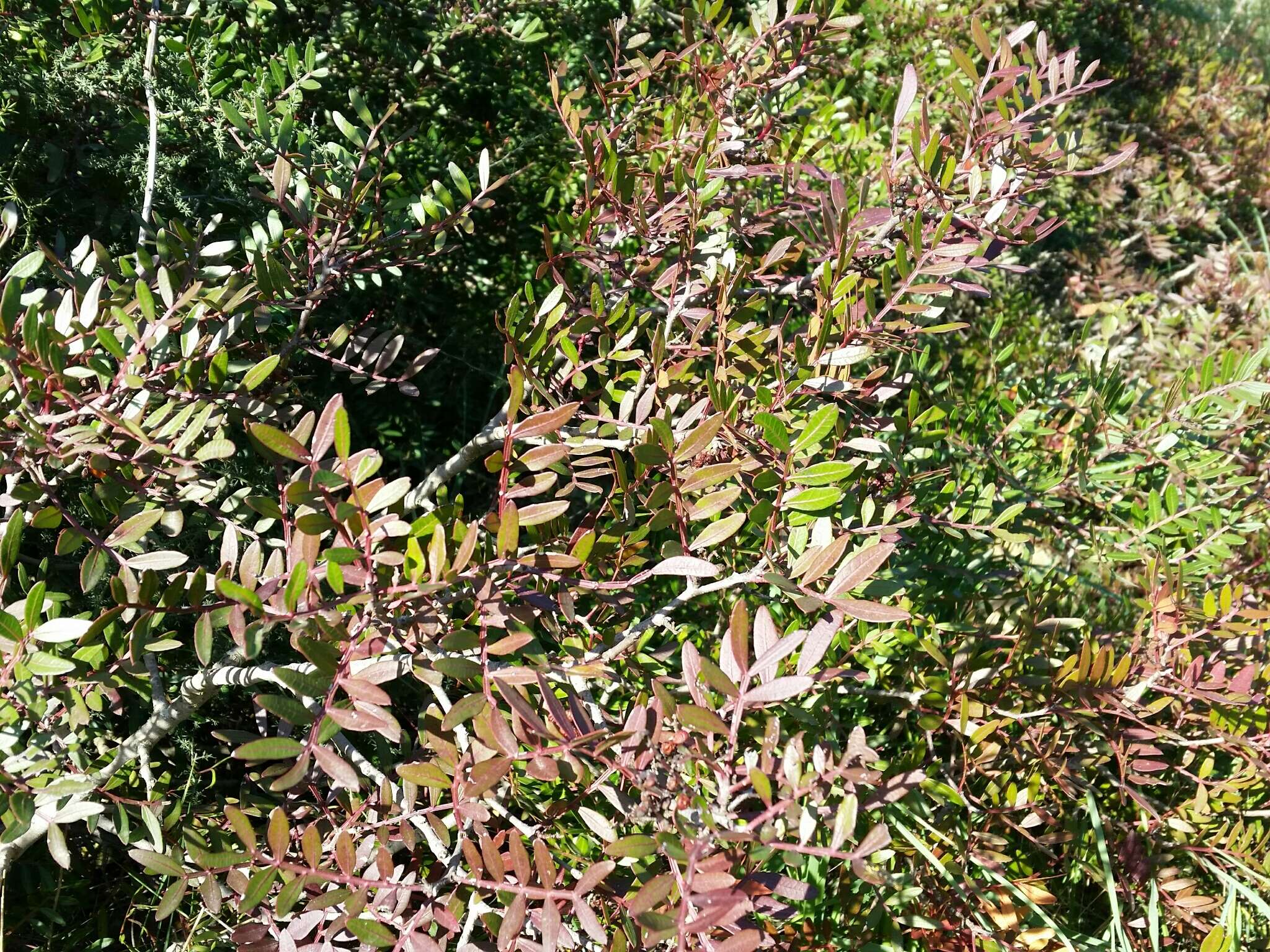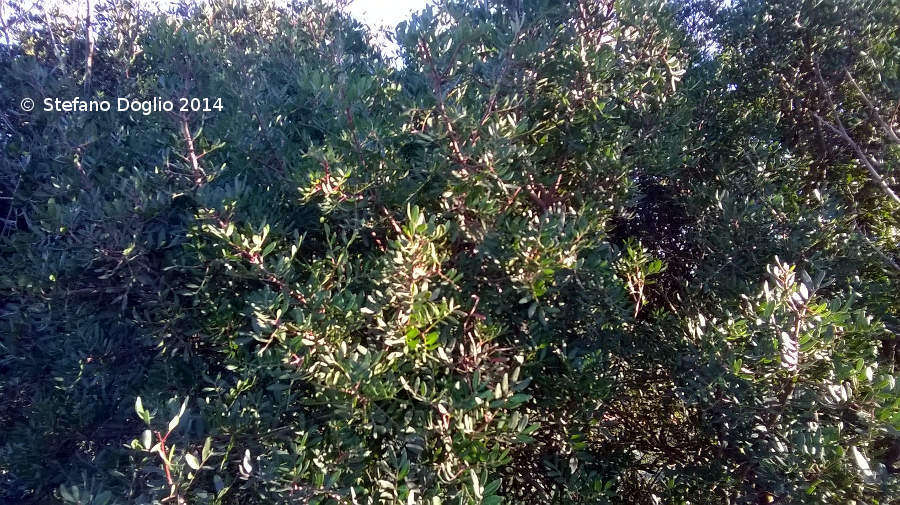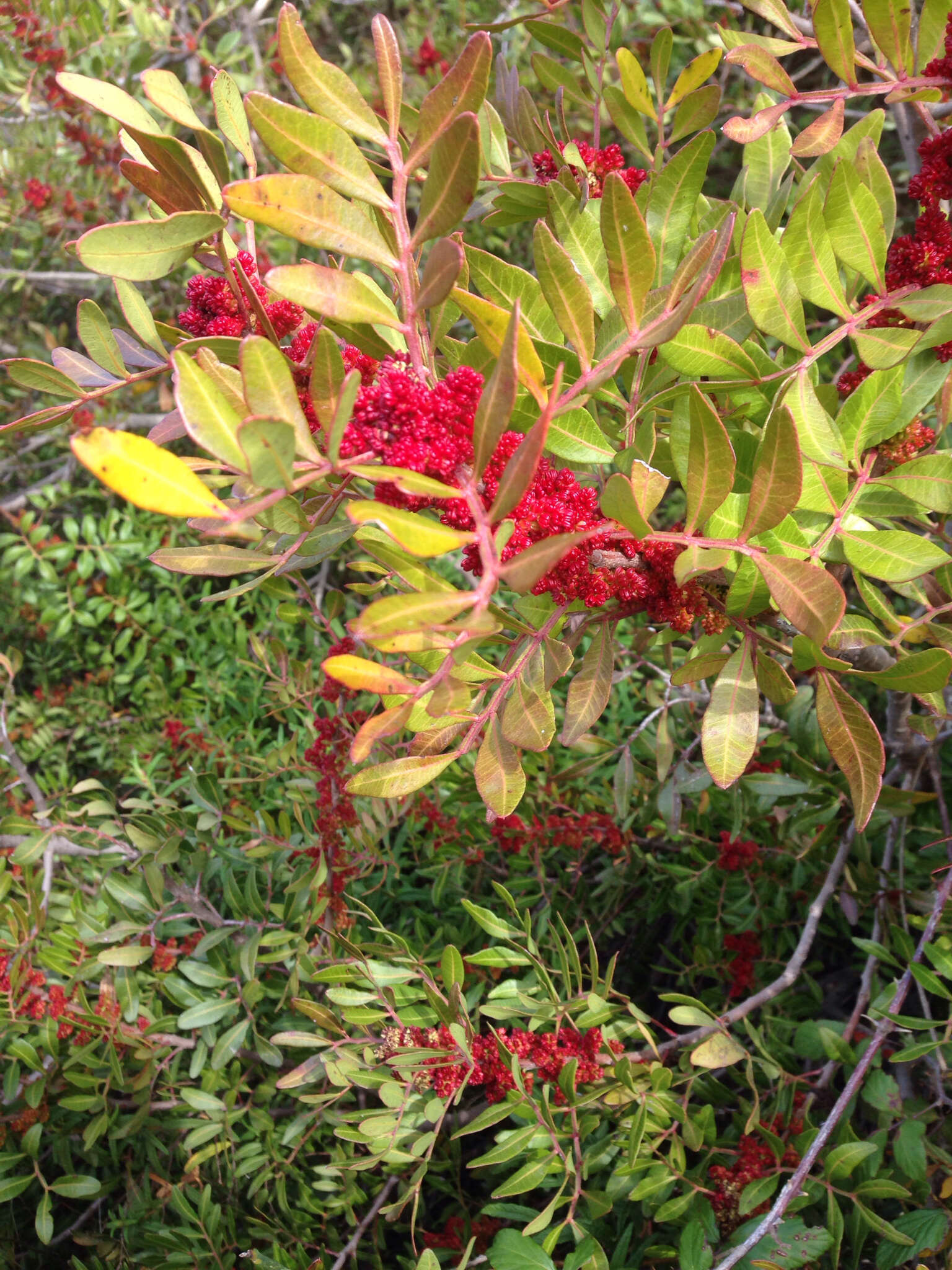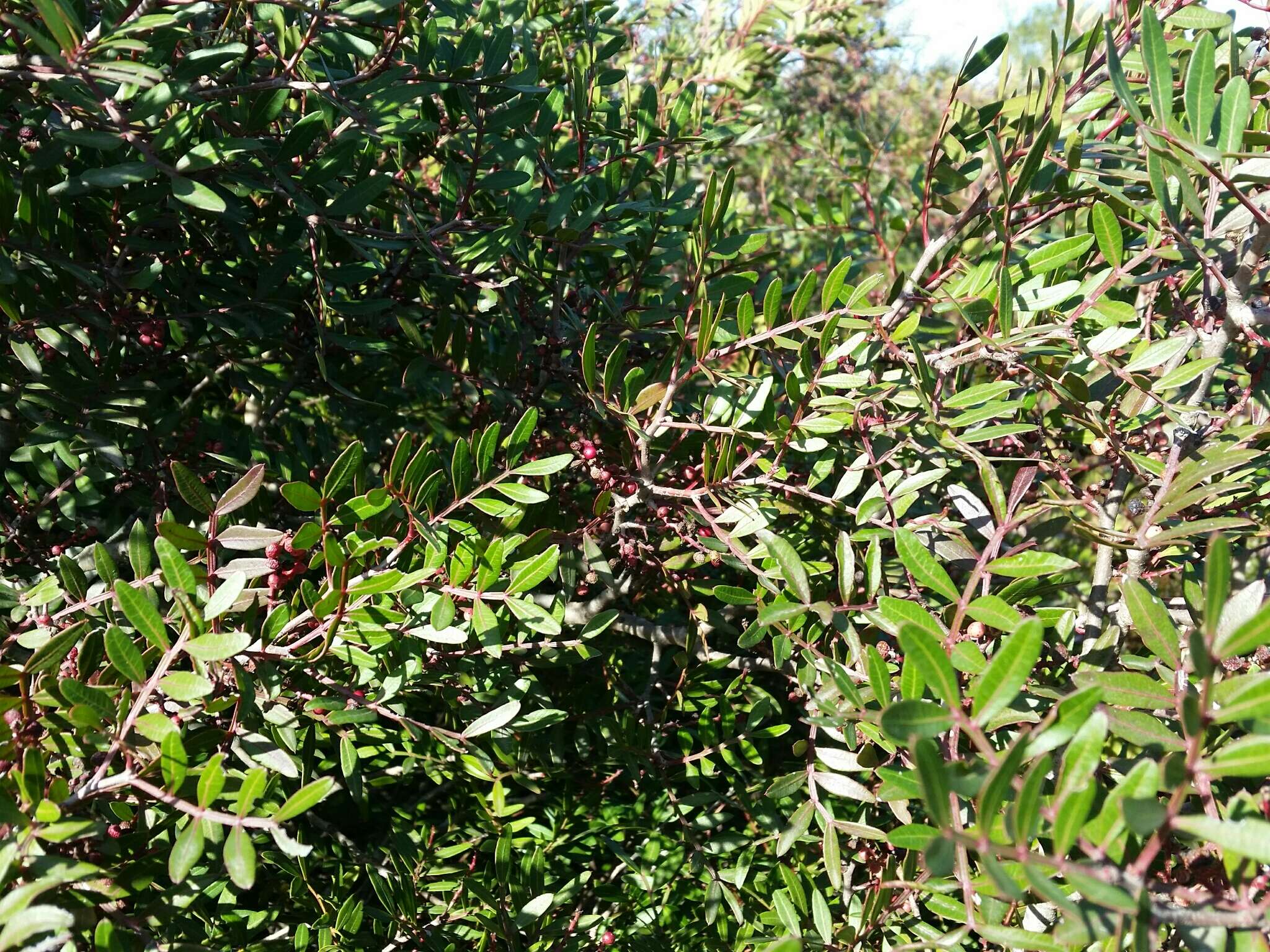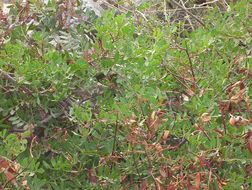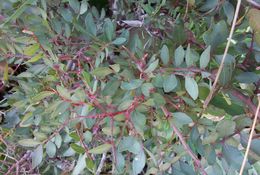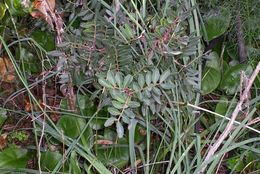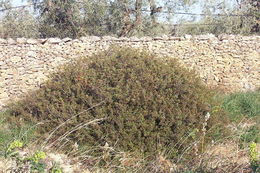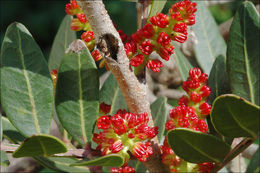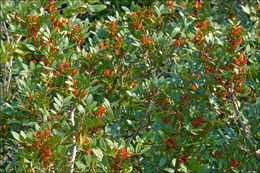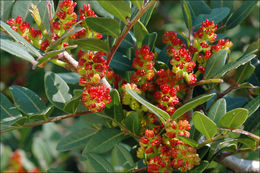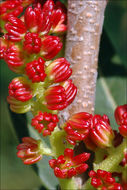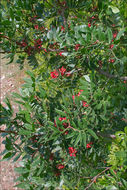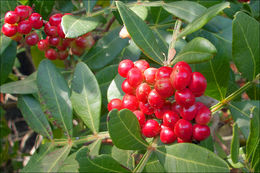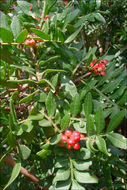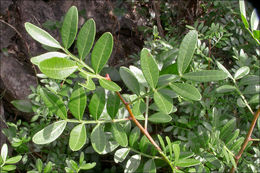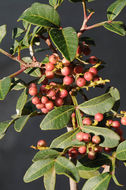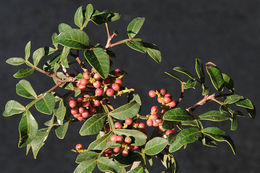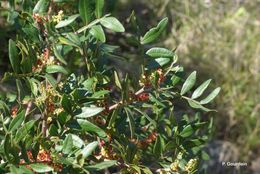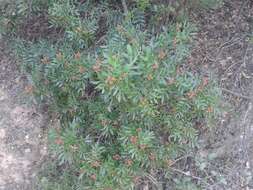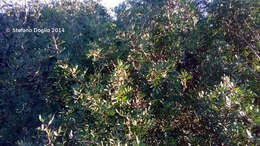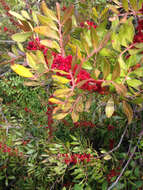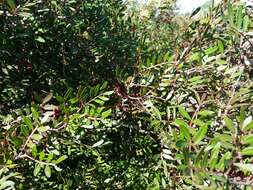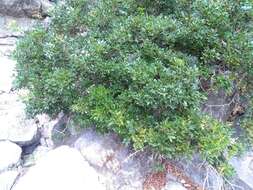-
-
-
-
-
-
-
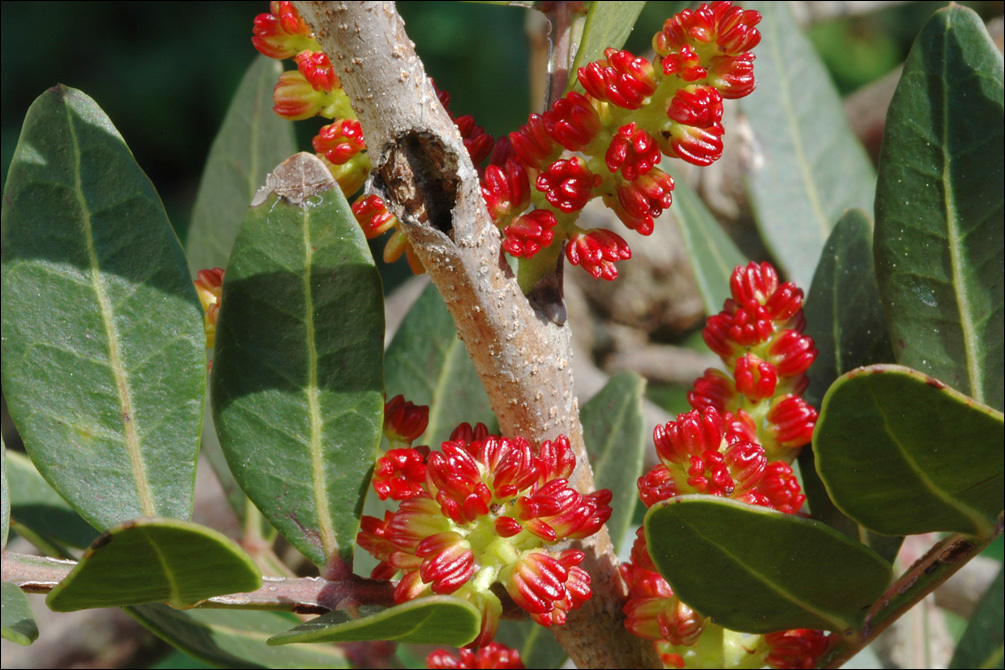
Slo.: no name. - Habitat: Open maquis, almost flat, skeletal, calcareous ground, full sun, elevation 30 m (100 feet), average precipitations ~ 980 mm/year, average temperature 12-15 deg C, Mediterranean phytogeographical region.- Substratum: soil among rocks. - Comment: Pistachia lentiscus is a Mediterranean species growing in all countries around the Mediterranean Sea (except in Slovenia). It enters the Alps only in their extreme south west part in a very small region. This bush or low tree, quite common in maquis, is beautiful in spring when in bloom and also in late summer when in fruit because of its bright red flowers (male plants) and red fruits (becoming black). Male and female flowers are born on different plants. Female flowers are greenish. - Pistachia lentiscus can be distinguished from other three similar and common Mediterranean species of genus Pistachia, namely pistachio nut (Pistachia vera), turpentine tree (Pistachia terebinthus) and Pistachia atlantica by its even-pinnate leaves, which have no end leaflet. All others have odd-pinnate leaves. The leaflets are rounded but have a small point at the end (are mucronate). - The plants are sometimes cultivated and used for diverse purposes - in chewing gum, in sweets, liqueurs and in production of mastics, a resin used for conservation and refreshment of old oil paintings. - Ref.: (1) D. Aeschimann, K. Lauber, D.M. Moser, J.P. Theurillat, Flora Alpina, Vol. 1., Haupt (2004), p 1042. (2) I. Schnfelder, P. Schnfelder, Kosmos Atlas Mittelmeer- und Kanarenflora, Kosmos, (2002), p 112. (3) M. Blamey, C. Grey-Wilson, Wild Flowers of the Mediterranean, A & C Black, London (2005), p 127. (4) R. Domac, Flora Hrvatske (Flora of Croatia) (in Croatian), kolska Knjiga, Zagreb (1994), p 154. (5) D. Seidel, Blumen am Mittelmeer, BLV (2002), p 216.
-
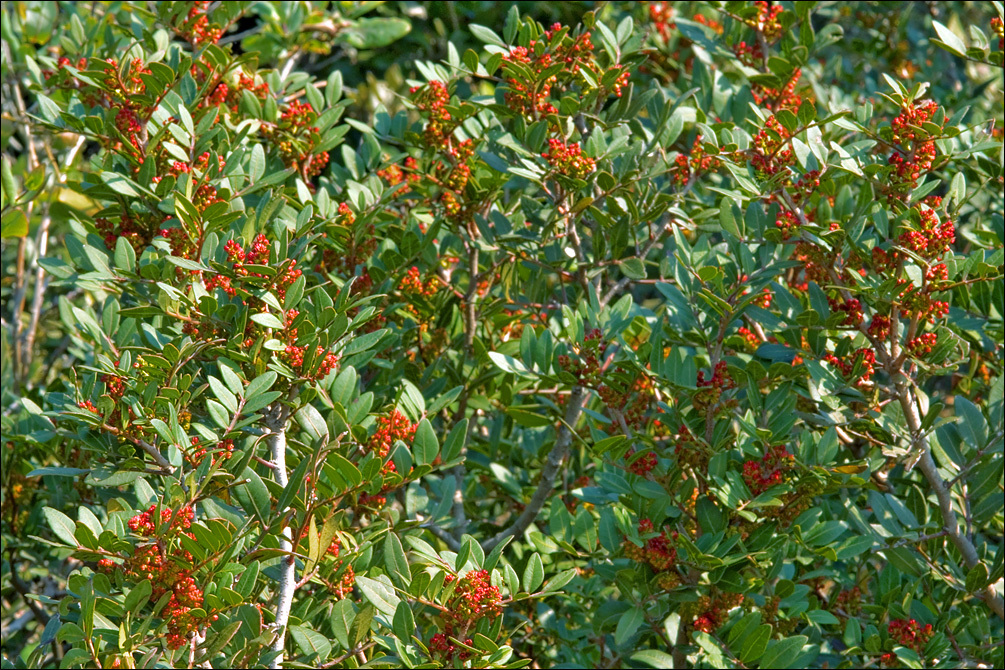
Slo.: no name. - Habitat: Open maquis, almost flat, skeletal, calcareous ground, full sun, elevation 30 m (100 feet), average precipitations ~ 980 mm/year, average temperature 12-15 deg C, Mediterranean phytogeographical region.- Substratum: soil among rocks. - Comment: Pistachia lentiscus is a Mediterranean species growing in all countries around the Mediterranean Sea (except in Slovenia). It enters the Alps only in their extreme south west part in a very small region. This bush or low tree, quite common in maquis, is beautiful in spring when in bloom and also in late summer when in fruit because of its bright red flowers (male plants) and red fruits (becoming black). Male and female flowers are born on different plants. Female flowers are greenish. - Pistachia lentiscus can be distinguished from other three similar and common Mediterranean species of genus Pistachia, namely pistachio nut (Pistachia vera), turpentine tree (Pistachia terebinthus) and Pistachia atlantica by its even-pinnate leaves, which have no end leaflet. All others have odd-pinnate leaves. The leaflets are rounded but have a small point at the end (are mucronate). - The plants are sometimes cultivated and used for diverse purposes - in chewing gum, in sweets, liqueurs and in production of mastics, a resin used for conservation and refreshment of old oil paintings. - Ref.: (1) D. Aeschimann, K. Lauber, D.M. Moser, J.P. Theurillat, Flora Alpina, Vol. 1., Haupt (2004), p 1042. (2) I. Schnfelder, P. Schnfelder, Kosmos Atlas Mittelmeer- und Kanarenflora, Kosmos, (2002), p 112. (3) M. Blamey, C. Grey-Wilson, Wild Flowers of the Mediterranean, A & C Black, London (2005), p 127. (4) R. Domac, Flora Hrvatske (Flora of Croatia) (in Croatian), kolska Knjiga, Zagreb (1994), p 154. (5) D. Seidel, Blumen am Mittelmeer, BLV (2002), p 216.
-

Slo.: no name. - Habitat: Open maquis, almost flat, skeletal, calcareous ground, full sun, elevation 30 m (100 feet), average precipitations ~ 980 mm/year, average temperature 12-15 deg C, Mediterranean phytogeographical region.- Substratum: soil among rocks. - Comment: Pistachia lentiscus is a Mediterranean species growing in all countries around the Mediterranean Sea (except in Slovenia). It enters the Alps only in their extreme south west part in a very small region. This bush or low tree, quite common in maquis, is beautiful in spring when in bloom and also in late summer when in fruit because of its bright red flowers (male plants) and red fruits (becoming black). Male and female flowers are born on different plants. Female flowers are greenish. - Pistachia lentiscus can be distinguished from other three similar and common Mediterranean species of genus Pistachia, namely pistachio nut (Pistachia vera), turpentine tree (Pistachia terebinthus) and Pistachia atlantica by its even-pinnate leaves, which have no end leaflet. All others have odd-pinnate leaves. The leaflets are rounded but have a small point at the end (are mucronate). - The plants are sometimes cultivated and used for diverse purposes - in chewing gum, in sweets, liqueurs and in production of mastics, a resin used for conservation and refreshment of old oil paintings. - Ref.: (1) D. Aeschimann, K. Lauber, D.M. Moser, J.P. Theurillat, Flora Alpina, Vol. 1., Haupt (2004), p 1042. (2) I. Schnfelder, P. Schnfelder, Kosmos Atlas Mittelmeer- und Kanarenflora, Kosmos, (2002), p 112. (3) M. Blamey, C. Grey-Wilson, Wild Flowers of the Mediterranean, A & C Black, London (2005), p 127. (4) R. Domac, Flora Hrvatske (Flora of Croatia) (in Croatian), kolska Knjiga, Zagreb (1994), p 154. (5) D. Seidel, Blumen am Mittelmeer, BLV (2002), p 216.
-
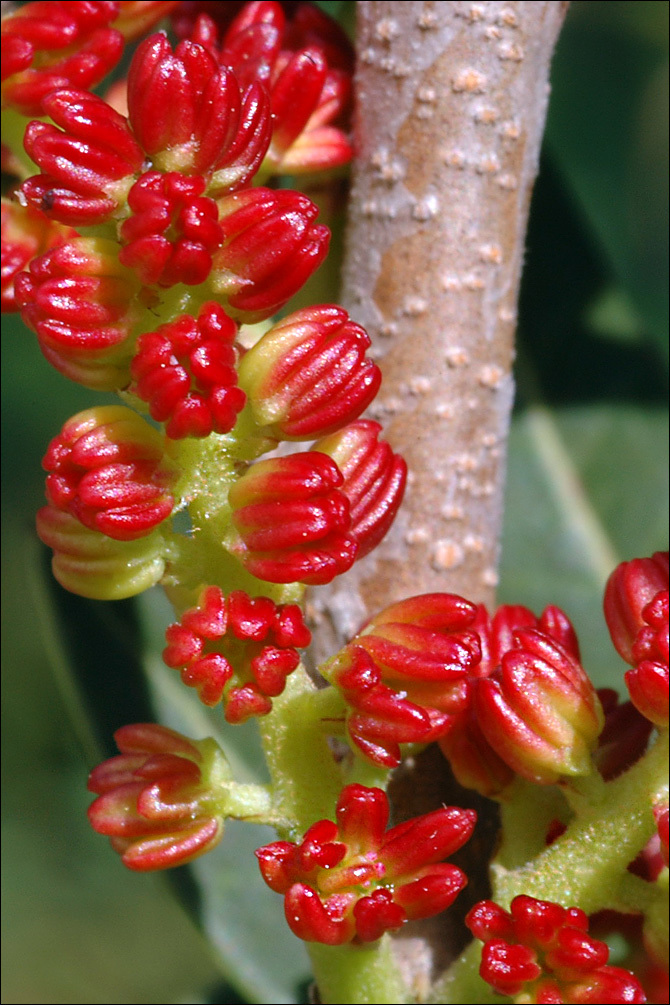
Slo.: no name. - Habitat: Open maquis, almost flat, skeletal, calcareous ground, full sun, elevation 30 m (100 feet), average precipitations ~ 980 mm/year, average temperature 12-15 deg C, Mediterranean phytogeographical region.- Substratum: soil among rocks. - Comment: Pistachia lentiscus is a Mediterranean species growing in all countries around the Mediterranean Sea (except in Slovenia). It enters the Alps only in their extreme south west part in a very small region. This bush or low tree, quite common in maquis, is beautiful in spring when in bloom and also in late summer when in fruit because of its bright red flowers (male plants) and red fruits (becoming black). Male and female flowers are born on different plants. Female flowers are greenish. - Pistachia lentiscus can be distinguished from other three similar and common Mediterranean species of genus Pistachia, namely pistachio nut (Pistachia vera), turpentine tree (Pistachia terebinthus) and Pistachia atlantica by its even-pinnate leaves, which have no end leaflet. All others have odd-pinnate leaves. The leaflets are rounded but have a small point at the end (are mucronate). - The plants are sometimes cultivated and used for diverse purposes - in chewing gum, in sweets, liqueurs and in production of mastics, a resin used for conservation and refreshment of old oil paintings. - Ref.: (1) D. Aeschimann, K. Lauber, D.M. Moser, J.P. Theurillat, Flora Alpina, Vol. 1., Haupt (2004), p 1042. (2) I. Schnfelder, P. Schnfelder, Kosmos Atlas Mittelmeer- und Kanarenflora, Kosmos, (2002), p 112. (3) M. Blamey, C. Grey-Wilson, Wild Flowers of the Mediterranean, A & C Black, London (2005), p 127. (4) R. Domac, Flora Hrvatske (Flora of Croatia) (in Croatian), kolska Knjiga, Zagreb (1994), p 154. (5) D. Seidel, Blumen am Mittelmeer, BLV (2002), p 216.
-

Slo.: no name. - Habitat: Open maquis, almost flat, skeletal, calcareous ground; full sun, elevation 25 m (80 feet), average precipitations ~ 950 mm/year, average temperature 12-15 deg C, Mediterranean phytogeographical region. Substratum: soil among rocks. Comment: Pistachia lentiscus is a Mediterranean species growing in all countries around the Mediterranean Sea (except in Slovenia). It enters the Alps only in their extreme south west part in a very small region. This bush or low tree, quite common in maquis, is beautiful in spring when in bloom and also in late summer when in fruit because of its bright red flowers (male plants) and red fruits (becoming black). Male and female flowers are born on different plants. Female flowers are greenish. Pistachia lentiscus can be distinguished from other three similar and common Mediterranean species of genus Pistachia, namely pistachio nut (Pistachia vera), turpentine tree (Pistachia terebinthus) and Pistachia atlantica by its even-pinnate leaves, which have no end leaflet. All others have odd-pinnate leaves. The leaflets are rounded but have a small point at the end (are mucronate). The plants are sometimes cultivated and used for diverse purposes - in chewing gum, in sweets, liqueurs and in production of mastics, a resin used for conservation and refreshment of old oil paintings. Ref.: (1) D. Aeschimann, K. Lauber, D.M. Moser, J.P. Theurillat, Flora Alpina, Vol. 1., Haupt (2004), p 1042. (2) I. Schnfelder, P. Schnfelder, Kosmos Atlas Mittelmeer- und Kanarenflora, Kosmos, (2002), p 112. (3) M. Blamey, C. Grey-Wilson, Wild Flowers of the Mediterranean, A & C Black, London (2005), p 127. (4) R. Domac, Flora Hrvatske (Flora of Croatia) (in Croatian), kolska Knjiga, Zagreb (1994), p 154. (5) D. Seidel, Blumen am Mittelmeer, BLV (2002), p 216.
-
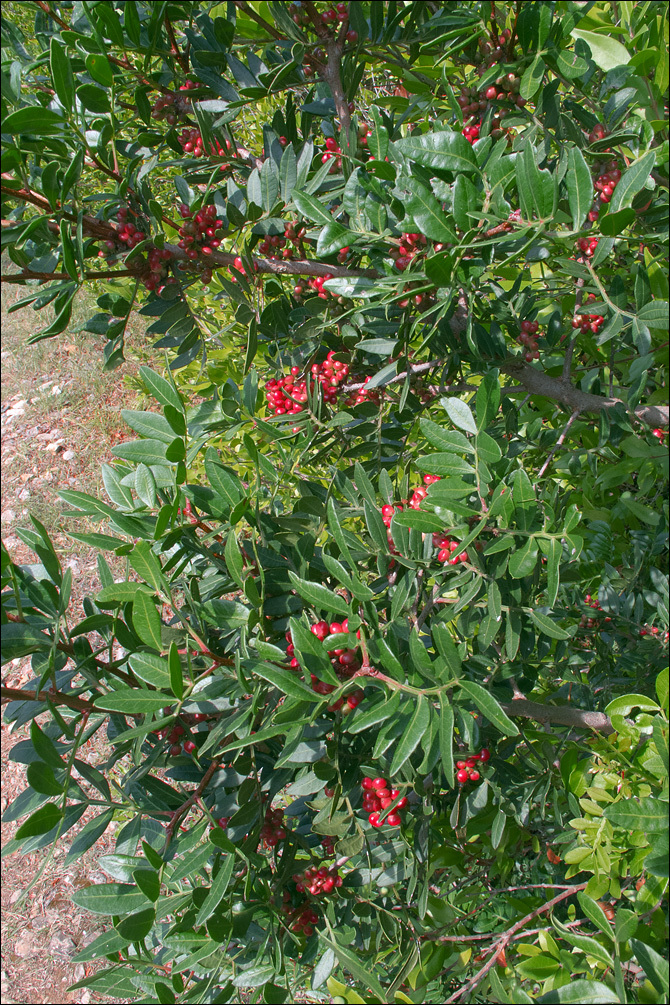
Slo.: no name. - Habitat: Open maquis, almost flat, skeletal, calcareous ground; full sun, elevation 25 m (80 feet), average precipitations ~ 950 mm/year, average temperature 12-15 deg C, Mediterranean phytogeographical region. Substratum: soil among rocks. Comment: Pistachia lentiscus is a Mediterranean species growing in all countries around the Mediterranean Sea (except in Slovenia). It enters the Alps only in their extreme south west part in a very small region. This bush or low tree, quite common in maquis, is beautiful in spring when in bloom and also in late summer when in fruit because of its bright red flowers (male plants) and red fruits (becoming black). Male and female flowers are born on different plants. Female flowers are greenish. Pistachia lentiscus can be distinguished from other three similar and common Mediterranean species of genus Pistachia, namely pistachio nut (Pistachia vera), turpentine tree (Pistachia terebinthus) and Pistachia atlantica by its even-pinnate leaves, which have no end leaflet. All others have odd-pinnate leaves. The leaflets are rounded but have a small point at the end (are mucronate). The plants are sometimes cultivated and used for diverse purposes - in chewing gum, in sweets, liqueurs and in production of mastics, a resin used for conservation and refreshment of old oil paintings. Ref.: (1) D. Aeschimann, K. Lauber, D.M. Moser, J.P. Theurillat, Flora Alpina, Vol. 1., Haupt (2004), p 1042. (2) I. Schnfelder, P. Schnfelder, Kosmos Atlas Mittelmeer- und Kanarenflora, Kosmos, (2002), p 112. (3) M. Blamey, C. Grey-Wilson, Wild Flowers of the Mediterranean, A & C Black, London (2005), p 127. (4) R. Domac, Flora Hrvatske (Flora of Croatia) (in Croatian), kolska Knjiga, Zagreb (1994), p 154. (5) D. Seidel, Blumen am Mittelmeer, BLV (2002), p 216.
-
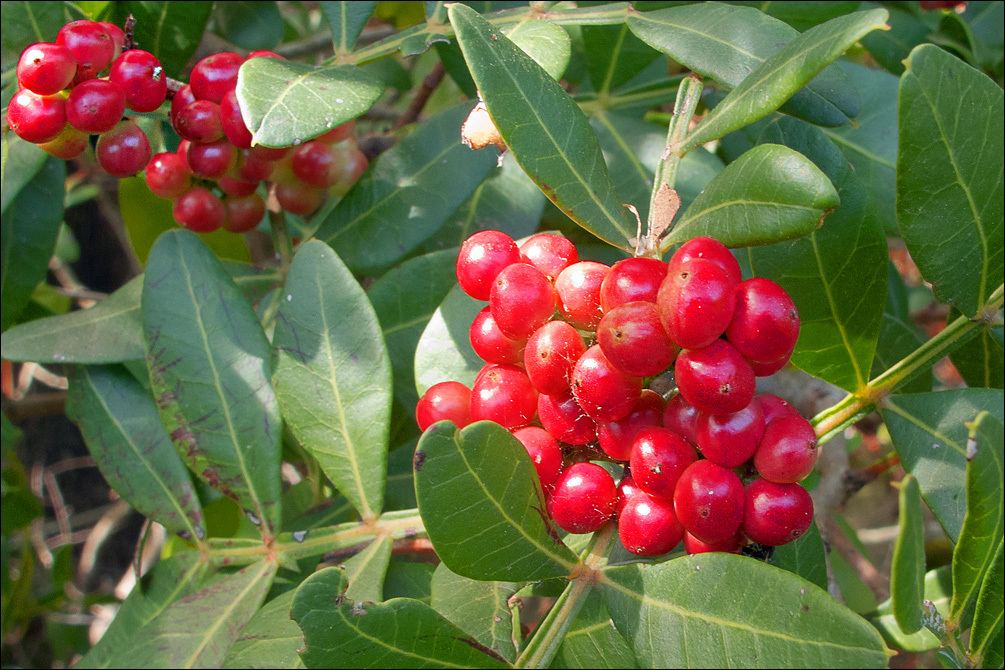
Slo.: no name. - Habitat: Open maquis, almost flat, skeletal, calcareous ground; full sun, elevation 25 m (80 feet), average precipitations ~ 950 mm/year, average temperature 12-15 deg C, Mediterranean phytogeographical region. Substratum: soil among rocks. Comment: Pistachia lentiscus is a Mediterranean species growing in all countries around the Mediterranean Sea (except in Slovenia). It enters the Alps only in their extreme south west part in a very small region. This bush or low tree, quite common in maquis, is beautiful in spring when in bloom and also in late summer when in fruit because of its bright red flowers (male plants) and red fruits (becoming black). Male and female flowers are born on different plants. Female flowers are greenish. Pistachia lentiscus can be distinguished from other three similar and common Mediterranean species of genus Pistachia, namely pistachio nut (Pistachia vera), turpentine tree (Pistachia terebinthus) and Pistachia atlantica by its even-pinnate leaves, which have no end leaflet. All others have odd-pinnate leaves. The leaflets are rounded but have a small point at the end (are mucronate). The plants are sometimes cultivated and used for diverse purposes - in chewing gum, in sweets, liqueurs and in production of mastics, a resin used for conservation and refreshment of old oil paintings. Ref.: (1) D. Aeschimann, K. Lauber, D.M. Moser, J.P. Theurillat, Flora Alpina, Vol. 1., Haupt (2004), p 1042. (2) I. Schnfelder, P. Schnfelder, Kosmos Atlas Mittelmeer- und Kanarenflora, Kosmos, (2002), p 112. (3) M. Blamey, C. Grey-Wilson, Wild Flowers of the Mediterranean, A & C Black, London (2005), p 127. (4) R. Domac, Flora Hrvatske (Flora of Croatia) (in Croatian), kolska Knjiga, Zagreb (1994), p 154. (5) D. Seidel, Blumen am Mittelmeer, BLV (2002), p 216.
-
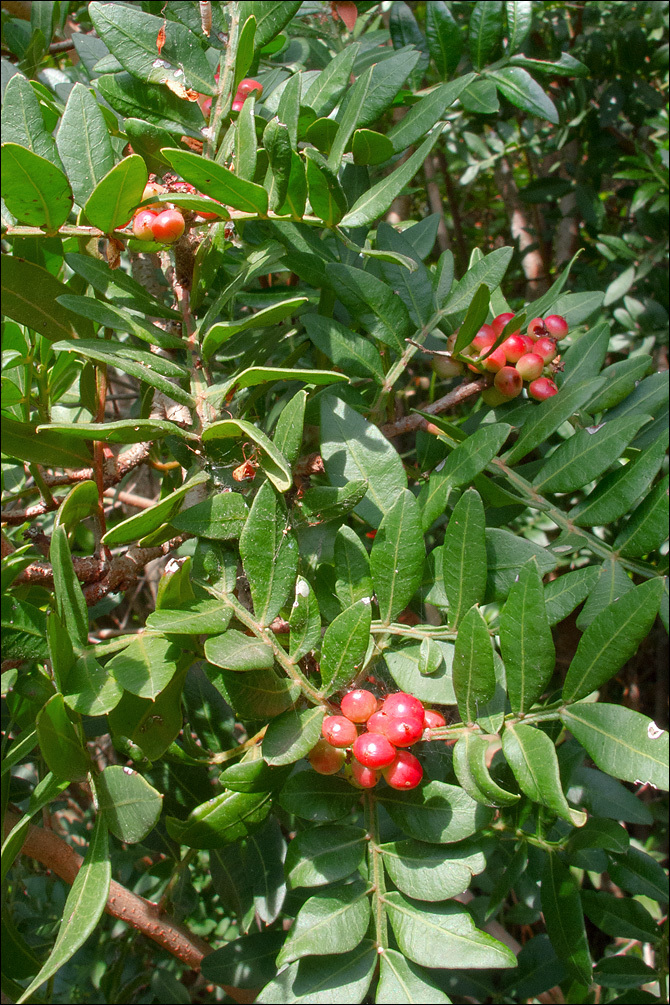
Slo.: no name. - Habitat: Open maquis, almost flat, skeletal, calcareous ground; full sun, elevation 25 m (80 feet), average precipitations ~ 950 mm/year, average temperature 12-15 deg C, Mediterranean phytogeographical region. Substratum: soil among rocks. Comment: Pistachia lentiscus is a Mediterranean species growing in all countries around the Mediterranean Sea (except in Slovenia). It enters the Alps only in their extreme south west part in a very small region. This bush or low tree, quite common in maquis, is beautiful in spring when in bloom and also in late summer when in fruit because of its bright red flowers (male plants) and red fruits (becoming black). Male and female flowers are born on different plants. Female flowers are greenish. Pistachia lentiscus can be distinguished from other three similar and common Mediterranean species of genus Pistachia, namely pistachio nut (Pistachia vera), turpentine tree (Pistachia terebinthus) and Pistachia atlantica by its even-pinnate leaves, which have no end leaflet. All others have odd-pinnate leaves. The leaflets are rounded but have a small point at the end (are mucronate). The plants are sometimes cultivated and used for diverse purposes - in chewing gum, in sweets, liqueurs and in production of mastics, a resin used for conservation and refreshment of old oil paintings. Ref.: (1) D. Aeschimann, K. Lauber, D.M. Moser, J.P. Theurillat, Flora Alpina, Vol. 1., Haupt (2004), p 1042. (2) I. Schnfelder, P. Schnfelder, Kosmos Atlas Mittelmeer- und Kanarenflora, Kosmos, (2002), p 112. (3) M. Blamey, C. Grey-Wilson, Wild Flowers of the Mediterranean, A & C Black, London (2005), p 127. (4) R. Domac, Flora Hrvatske (Flora of Croatia) (in Croatian), kolska Knjiga, Zagreb (1994), p 154. (5) D. Seidel, Blumen am Mittelmeer, BLV (2002), p 216.
-
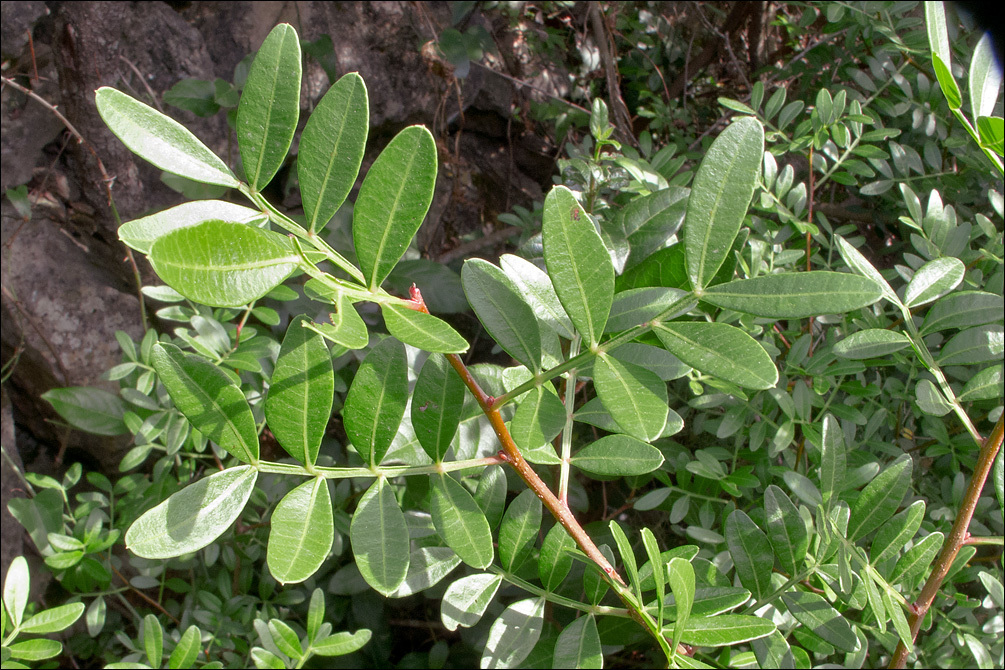
Slo.: no name. - Habitat: Open maquis, almost flat, skeletal, calcareous ground; full sun, elevation 25 m (80 feet), average precipitations ~ 950 mm/year, average temperature 12-15 deg C, Mediterranean phytogeographical region. Substratum: soil among rocks. Comment: Pistachia lentiscus is a Mediterranean species growing in all countries around the Mediterranean Sea (except in Slovenia). It enters the Alps only in their extreme south west part in a very small region. This bush or low tree, quite common in maquis, is beautiful in spring when in bloom and also in late summer when in fruit because of its bright red flowers (male plants) and red fruits (becoming black). Male and female flowers are born on different plants. Female flowers are greenish. Pistachia lentiscus can be distinguished from other three similar and common Mediterranean species of genus Pistachia, namely pistachio nut (Pistachia vera), turpentine tree (Pistachia terebinthus) and Pistachia atlantica by its even-pinnate leaves, which have no end leaflet. All others have odd-pinnate leaves. The leaflets are rounded but have a small point at the end (are mucronate). The plants are sometimes cultivated and used for diverse purposes - in chewing gum, in sweets, liqueurs and in production of mastics, a resin used for conservation and refreshment of old oil paintings. Ref.: (1) D. Aeschimann, K. Lauber, D.M. Moser, J.P. Theurillat, Flora Alpina, Vol. 1., Haupt (2004), p 1042. (2) I. Schnfelder, P. Schnfelder, Kosmos Atlas Mittelmeer- und Kanarenflora, Kosmos, (2002), p 112. (3) M. Blamey, C. Grey-Wilson, Wild Flowers of the Mediterranean, A & C Black, London (2005), p 127. (4) R. Domac, Flora Hrvatske (Flora of Croatia) (in Croatian), kolska Knjiga, Zagreb (1994), p 154. (5) D. Seidel, Blumen am Mittelmeer, BLV (2002), p 216.
-
Pistacia lentiscus is a large evergreen Mediterranean shrub. Here u can see its fruits, in winter some fruit will remain red for advertisement and the rest will blacken and will be eaten and dispersed by birds.
-
Pistacia lentiscus is a large evergreen Mediterranean shrub. Here u can see its fruits, in winter some fruit will remain red for advertisement and the rest will blacken and will be eaten and dispersed by birds.
-
-
-
-
-
-
-



